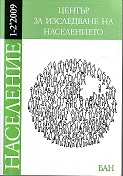РЕПРОДУКТИВНИ НАМЕРЕНИЯ НА НАСЕЛЕНИЕТО В БЛИЗКА И ДАЛЕЧНА ПЕРСПЕКТИВА
REPRODUCTIVE INTENTIONS OF THE BULGARIAN POPULATION IN NEAR AND DISTANT FUTURE
Author(s): Tatyana Kotzeva, Elitsa DimitrovaSubject(s): Social Sciences
Published by: Институт за изследване на населението и човека - Българска академия на науките
Summary/Abstract: In this paper we analyze the intentions and the plans of the men and the women in Bulgaria to have a child in the near future (within the next three years following the second wave of Gender and Generation Survey, conducted in 2007) or at a distant moment of time. The results show that the two child family model is still prevailing reproductive norm in the recent Bulgarian society. The childless individuals have the highest reproductive intentions in comparison to the respondents who already have children. The men more often have plans for a second child than the women. The respondents who live with a partner (in a marital union or in cohabitation) have more precisely time framed reproductive plans than the people who are single. The reproductive intentions decline as the respondents’ reproductive aging (measured by their age) advances. The results from the descriptive analyses confirm also that permanent childlessness is excluded as a reproductive intention among various segments of the Bulgarian population. It is completely ruled out among the Roma population. The reproductive goals in terms of planned/ expected number of children are highest among this ethnic group when compared to the reproductive intention of the people with Bulgarian or Turkish ethnicity. The respondents from the Turkish ethnic group more often plan for another child in comparison to the ethnic Bulgarians who already have one child. The individuals from the Roma ethnic group more often plan for a third child than the ethnic Bulgarian or Turkish respondents at parity two.
Journal: Население
- Issue Year: 2009
- Issue No: 1-2
- Page Range: 67-89
- Page Count: 23
- Language: Bulgarian
- Content File-PDF

